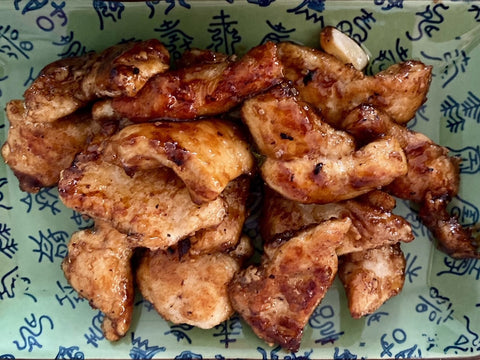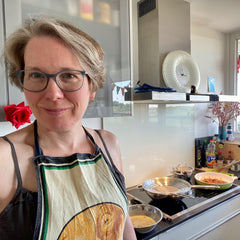RECIPE: Ponzu chicken by Sylke Krämer

Servings: 3
Ingredients
- 3 portions of Japanese rice
- 600 g chicken breast, cut into bite sized pieces, approximately 8 mm thick
- Potato starch
- Neutral tasting oil
- 90 ml ponzu
- 2 Tbsp mirin
- 2 Tbsp sake
- 2 tsp light brown sugar (or less, to taste)
- Rice
- Miso soup
- A salad or pickled vegetables, e.g. a Napa cabbage salad

Steps
- Prepare your rice and have it steam away while you are making the chicken.
- Gather all of your ingredients and cut the spring onions. Put them in a pretty bowl for later.
- Next cut the chicken into bite sized pieces. Add some potato starch to a bowl that can easily hold all of the chicken and add the pieces in badges to get them well dusted in the starch.
- Mix all of the sauce ingredients in a small bowl or measuring jug. Stir until the sugar has been fully absorbed.
- Heat 2 to 3 Tbsp of oil in a big flat frying pan on high heat. Place a big plate nearby.
- Fry the chicken in badges. Add just enough of the pieces to cover the pan bottom. Make sure to flatten them. Wait for about 2 minutes and test whether they already come off easily from the bottom of the pan. If they do, check the degree of browning. If not brown yet, give them another minute. (Reduce the heat somewhat if things get too burned.) If brown enough turn them over and add some more oil. Once turned, wait another 2 minutes and check again. When brown enough remove the chicken pieces onto your plate nearby. Repeat until all chicken pieces have been fried.
- Turn the heat down to medium to high and scrape out all bigger burned bits with your spatula. If there is more than a little oil left, discard it. A splash of water might help to deglaze the pan. It should completely evaporate in the process.
- Give the sauce one more stir and pour it into your hot frying pan. Beware of steam rising up immediately. The sauce should quickly start to bubble up and thicken somewhat. Reduce the temperature to medium. Add the chicken pieces back in and move them about until they are all well covered with the sticky sauce.
- Serve with hot rice and spring onions.
Notes: This can also be made with tofu.

About the author:
A German who lived for half of her life in other European countries (United Kingdom, the Netherlands, Ireland) but is now back in Germany. Her food preferences and cooking are heavily influenced by Indian and East Asian flavours, owing in part to life in multicultural London in the 1990s. She has been learning about Japanese cuisine since 2020 using mostly web resources - inspired by Kokoro care packages as they offer products that are often hard to get in this nook of the world.
Sylke and her home made food can be found on Instagram and Pixelfed under the name of “Sylkeweb”.




